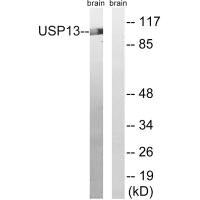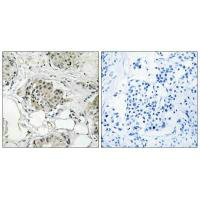
Western blot analysis of extracts from mouse brain cells, using USP13 antibody.
USP13 Antibody
CSB-PA970742
ApplicationsWestern Blot, ELISA, ImmunoHistoChemistry
Product group Antibodies
ReactivityHuman
TargetUSP13
Overview
- SupplierCusabio
- Product NameUSP13 Antibody
- Delivery Days Customer20
- ApplicationsWestern Blot, ELISA, ImmunoHistoChemistry
- CertificationResearch Use Only
- ClonalityPolyclonal
- ConjugateUnconjugated
- Gene ID8975
- Target nameUSP13
- Target descriptionubiquitin specific peptidase 13
- Target synonymsdeubiquitinating enzyme 13; ISOT3; IsoT-3; ubiquitin carboxyl-terminal hydrolase 13; ubiquitin specific peptidase 13 (isopeptidase T-3); ubiquitin specific protease 13 (isopeptidase T-3); ubiquitin thioesterase 13; ubiquitin thiolesterase 13; ubiquitin-specific-processing protease 13
- HostRabbit
- IsotypeIgG
- Protein IDQ92995
- Protein NameUbiquitin carboxyl-terminal hydrolase 13
- Scientific DescriptionDeubiquitinase that mediates deubiquitination of target proteins such as BECN1, MITF, SKP2 and USP10 and is involved in various processes such as autophagy and endoplasmic reticulum-associated degradation (ERAD). Component of a regulatory loop that controls autophagy and p53/TP53 levels: mediates deubiquitination of BECN1, a key regulator of autophagy, leading to stabilize the PIK3C3/VPS34-containing complexes. Also deubiquitinates USP10, an essential regulator of p53/TP53 stability. In turn, PIK3C3/VPS34-containing complexes regulate USP13 stability, suggesting the existence of a regulatory system by which PIK3C3/VPS34-containing complexes regulate p53/TP53 protein levels via USP10 and USP13. Recruited by nuclear UFD1 and mediates deubiquitination of SKP2, thereby regulating endoplasmic reticulum-associated degradation (ERAD). Mediates stabilization of SIAH2 independently of deubiquitinase activity: binds ubiquitinated SIAH2 and acts by impairing SIAH2 autoubiquitination. Has a weak deubiquitinase activity in vitro and preferentially cleaves Lys-63-linked polyubiquitin chains. In contrast to USP5, it is not able to mediate unanchored polyubiquitin disassembly. Able to cleave ISG15 in vitro; however, additional experiments are required to confirm such data. Timms K.M., Gene 217:101-106(1998). Mural R.J., Submitted (SEP-2005) to the EMBL/GenBank/DDBJ databases. Dephoure N., Proc. Natl. Acad. Sci. U.S.A. 105:10762-10767(2008).
- ReactivityHuman
- Storage Instruction-20°C or -80°C
- UNSPSC12352203

